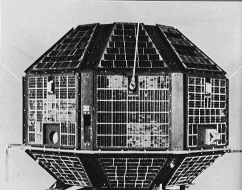|
|
Aryabhata
Full resolution image

 Mission Overview
Mission Overview
Aryabhata was India’s first satellite, named after a ancient Indian
mathematician (5th century AD). It was launched by the Russians on
19 April 1975 from Kapustin Yar. The 96.3 minute orbit had an apogee of 619
km and a perigee of 563 km, at an inclination of 50.7 degrees. Aryabhata was
built by the Indian Space Research Organization (ISRO) to conduct experiments
in X-ray astronomy, aeronomics, and solar physics. The spacecraft was a
26-sided polygon 1.4 m in diameter. All faces (except the top and bottom) were
covered with solar cells. A power failure halted experiments after 4 days
in orbit. All signals from the spacecraft were lost after 5 days of operation.
The satellite reentered the Earth’s atmosphere on 11 February 1992.
[Publications]
[All Missions]
[by Time]
[by Energy]
Page authors: Lorella Angelini Jesse Allen
HEASARC Home |
Observatories |
Archive |
Calibration |
Software |
Tools |
Students/Teachers/Public
Last modified: Thursday, 24-Sep-2020 17:37:05 EDT
|


